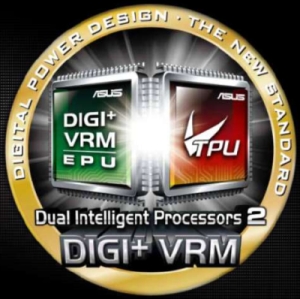Asus P67 1155 Sandybridge Sneak Peak
Dual Intelligent Processors 2
As the name suggests, this is a natural progression from our recently published article on Dual Intelligent Processors. It might be worth reading it first before attempting to digest the following!
EPU and Digi+ VRM
Digi+ VRM is expected to bring a whole new level of energy optimisation and system stability to the table. Falling under the EPU side of DIP, some of its key features are as follows –
1) Active VRM Signal Optimisation – In essence, power signals are transmitted as a frequency. The concept follows that if a stand alone microchip (independent of the CPU) can actively adjust this frequency depending on system loading, it can be tweaked in a manner that system voltages remain consistent and in turn potentially higher levels of efficiency and stability can be obtained.
2) Enhanced Load Line Calibration – Nobody likes Vdrop/Vdroop when overclocking processors. Without LLC, many boards force the end users to raise assigned voltages well above the required amount for the desired effect. Likewise, it sometimes follows that a fully enabled LLC function results in mild overvoltage. Digi+ VRM solves the problem by offering intermediate options, which can be configured within BIOS or Software.
3) VRM Duty Control – Lets face it, temperatures often have a direct impact on stability. Depending on VRM temperature, Duty Control will adjust power phase loading accordingly. Once again, this occurs on the fly and is powered by a dedicated microchip and (presumably) a rather sophisticated set of algorithms to make it all happen.
TPU
The TPU aspects of DIP remain very much the same as before. Regardless it remains to be as impressive as ever.
Accessibility
As before it is possible to access all aspects of DIP from the centralised AI Suite II application. Our previous testing indicated that the program wasn’t particularly costly in terms of memory utilisation however both we and Asus sympathise with those who fully disagree to installing software for features such as these.
With the P67 series it is possible to acccess the vast m
ajority of DIP related features directly from BIOS. Even still, for those who are too frightened to enter BIOS may also enable these features via flick switches on the PCB itself.
BT GO!
In a nutshell, BT GO! bares similarities with the existing RC Bluetooth concept. The facility allows the end user to sync their smartphone (Symbian, Android, Windows Mobile, iOS) with the P67 series Bluetooth Adapter in order to –
– File Share
– Internet Share
– Auto Overclock
– Control Windows Media Player
– Power Down / Restart System
Feature packed doesn’t even begin to describe these boards. Let’s continue…




